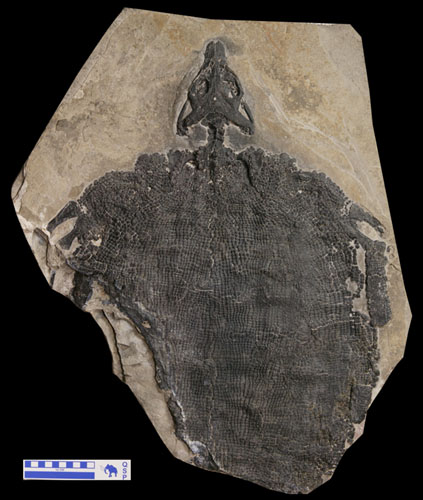Paleontologist LI Chun, Institute of Vertebrate Paleontology and Paleoanthropology (IVPP), Chinese Academy of Sciences, and his research team, reported a new genus and species of marine reptile, Sinosaurosphargis yunguiensis, from the Middle Triassic of Yunnan and Guizhou Provinces, southwestern China, according to a paper published in the Journal of Vertebrate Paleontology, 31(2), 2011.
This new species with closed upper temporal fenestrae has a ventrally open cheek. Its external nares are retracted, and its trunk region is short and of rounded contours. The trunk, neck, and proximal limb segments are covered by shield composed of small osteoderms. The dorsal ribs are broadened and flat, contacting one another along their length. The dorsal vertebrae have elongated, distally expanded transverse processes.
“This new diapsid reptile displays a highly derived postcranial skeletal anatomy convergent on cyamodontid placodonts. It represents the first representative from China of a lineage related to Saurosphargis from the Germanic Muschelkalk, and this find adds further support to the close faunal affinities shared by the Eastern and Western Tethyan realm”, said Dr. Xiao-Chun WU, coauthor, Canadian Museum of Nature, Ottawa.
“Saurosphargis, Sinosaurosphargis, and turtles are the only reptiles known with dorsal ribs transversely broadened to such an extent as to establish an anteroposterior contact with one another, forming a closed dorsal ‘rib basket’ (in turtles in the form of costal plates, integrated into the carapace)”, said Dr. Olivier Rieppel, the corresponding author, curator of the Field Museum, Chicago, “The presence of this rib structure in conjunction with a closed osteoderm covering in Sinosaurosphargis is extremely intriguing, because a derivation of the turtle carapace from an ancestral osteoderm covering has repeatedly been proposed. This scenario of turtle shell evolution conflicts with the absence of osteoderms in the ancestral turtle Odontochelys from the early Late Triassic of southwestern China. However, an alternative interpretation of Odontochelys considers its carapace reduced due to skeletal paedomorphosis as an adaptation to an aquatic mode of life.”
This work was supported mainly by the Major Basic Research Projects of the Ministry of Science and Technology of China, the National Natural Science Foundation of China, and the special grant for fossil excavation and preparation of the Chinese Academy of Sciences.
 Fig.1: The holotype of Sinosaurosphargis yunguiensis, gen et sp. nov. (IVPP V 17040), in dorsal view. (Image by LI Chun) |
